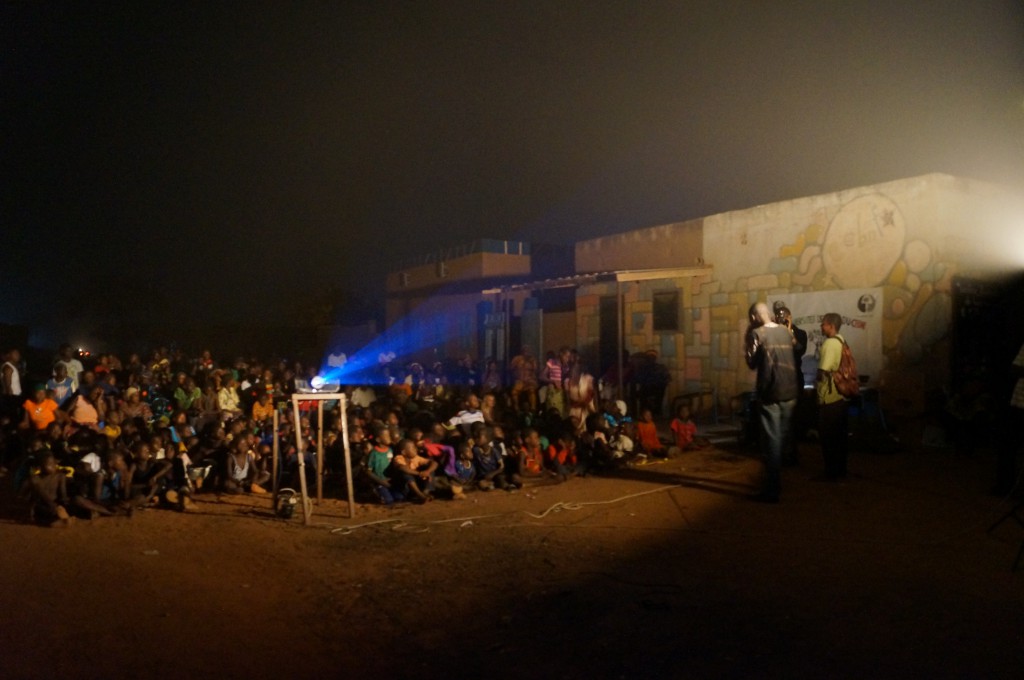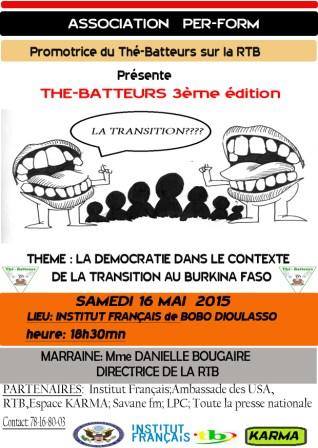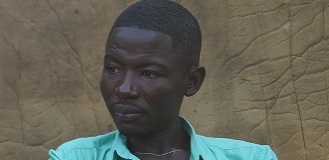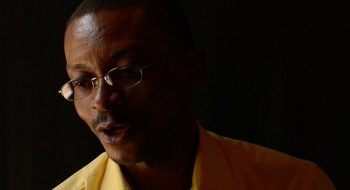Fiona Dragstra – Is a picture worth a thousand words?
Ouagadougou, May 11th, 2015.
In our Western world of written history and text, we often see this as the only place where knowledge is created and spread. Institutionalized knowledge is created and spread through words. Once not written down, something is subject to our own heavy interpretation, making it less valuable as facts, hence as our understanding of valuable and correct knowledge.
Our obsession with words as knowledge led to Western misunderstanding and misinterpretation of the rich histories of Africa in the past. We thought Africans did not have a history, a culture, because they did not have it written down. This, of course, is a huge misconception and is luckily something from the past. African oral histories are heavily researched and documented, making them ‘real’. The proverb ‘A picture is worth a thousand words’ explains that an image can contain all the complexities that we often try to capture in written word. Moreover, it is often way more powerful and intrusive than words – always staying in the forefront of your mind when you think of an issue connected with the image. Text is limited to a certain extend. Words can be very intrusive and powerful too – but they are not for everyone. Doing research in Burkina Faso on the use of ICT in society, the issue of access to information (often written down) keeps reappearing.
Text is limited to the extent that only people who can read and write can inform themselves through text. Analphabetic issues are still very present in contemporary Burkina Faso, often wedging a gap of access between the new and older generation. Only by looking at the statistics of people who read newspapers, and people who listen to the radio, it becomes evident that oral stories and news are very, if not the most, important sources of information for most people. Secondly, even if you can perhaps read in your own local language, all news and information in newspapers and on, for example, social media, French is the language that stands out. If you don’t master French, you’re left out. French writing and reading is learned at school. When you’ve not been to school, you might speak French, but participating in the ruling written information sources is difficult.
So how do analphabetic Burkinabés participate in their information society and where do they get there knowledge from? Is most of society excluded from discussion and information? Of course not! The options are countless. Radio, for one, is the most widespread and heavily used source of news. But there is more. Especially in Burkina, music and films are heavily used as information spreaders and crowd drawers. Burkina Faso has a rich history of filmmaking, and hosts the annual FESPACO in Ouagadougou. This film festival shows predominantly African movies from all over the continent, almost all of them documentaries of African contemporary and historical issues. Moreover, there is the annual Cine Droit Libre festival, organized by DroitLibre.tv, which shows African films, in French, English and local languages, often translated in Moré, the biggest language group in Burkina Faso. The festival shows mainly documentaries concerning human rights, liberty of expression, women empowerment, issues concerning education of the youth, and other contemporary issues in society. For people who cannot afford to buy a ticket for the festival, there are weekly film showings and debates afterwards which are organized in popular quartiers all over Ouagadougou, and increasingly in other big cities. Via these means, films and especially these issues become present in people’s lives, and they might recognize themselves in certain situations.
 Image: documentary by Adama Sorgho, about his mother who actively promotes women rights in their village, close to Tenkodogo. This movie was shown in a quartier populaire in Ouagadougou. Of course for free, and open for everyone. This picture was taken right after the movie, during the debate where people could ask questions and discuss what they had just seen (in French and Moré).
Image: documentary by Adama Sorgho, about his mother who actively promotes women rights in their village, close to Tenkodogo. This movie was shown in a quartier populaire in Ouagadougou. Of course for free, and open for everyone. This picture was taken right after the movie, during the debate where people could ask questions and discuss what they had just seen (in French and Moré).
The impact of images can also be contrary to what you intend to reach, and tell only one side of the story. As Chantal Naré, “cyberactivist”, blogger and coordinator of Droitlibre.tv states, an image rests in people’s mind. This is very positive when you make use of the right images. However, it also has its dangers. She gives two examples. First, on social media, during the xenophobic attacks in South Africa (April 2015), and the demonstrations in Burundi (May 2015), many violent photos were spread on social networks to show the intensity and gravity of the violence. However, as Chantal says, these images do not, tell the complexity of the conflict, but are used to shock others. Next, they are so intrusive that many people won’t want to know what is going on anymore, since the images are too violent to look at. With this, people look away from the conflict. Hence, there is no analysis of the conflict; it is just spreading images of severe violence. Another example of the power of an image lies in something she is highly involved in herself; the use of skin-whitening creams for women. She tells the story of female politicians that tell great speeches, and write wonderful pieces on women empowerment, and the need to accept and love their own bodies, without using skin creams. However, at the same time, these exact same women use skin-whitening creams themselves. Once again, the image does not match the story. You can then wonder what stays in peoples mind. The (written) story or the image of a nearly white woman…. Chantal urges for the importance of using images, films and texts that give a ‘correct’ view on the story of emancipation and women’s rights. She thinks things are moving in the right direction, but also mentions that there is still a long road ahead. But, she is convinced that images and films are necessary for sensibilisation, especially for the people who have been information poor.
Not only do films and photos help in the process of raising awareness on contemporary issues, so does music. Next to the major film festivals that Ouagadougou hosts annually, there are also many (and I mean many!) music festivals organized throughout the country. Two weeks ago this was Jazz à Ouaga (organized by Droitlibre.tv and many foreign embassies), this weekend it is Reggae City Festival, of course held on the date of Bob Marley’s death, “in loving memory”. Last night, the 10th of May, I went to the festival. There were hundreds of young Burkinabés, chanting to Bob Marley’s old classics, translated in Moré by the artists on stage. A big change with Jazz à Ouaga, where there was a conglomerate of all expats in Ouagadougou, and mainly an older, richer crowd. Reggae City Festival is for free, there cheap drinks, and it is held at the Maison de Jeunnesse – the hangout spot for all of Ouaga’s youth. During the concert, my friend translated the Moré texts in French to me – making it easier to understand. All people in the audience knew exactly what to say when. One of the artists had a song on bad politics, bad governance, Blaise Compaoré (the former president), and poverty. Every time he called Blaise’ name, the whole crowd waved and chanted “Bye bye”. It was impressive. After this artist, Karim, a young musician that I have met multiple times came on stage and sang intensively nous sommes fatigué! Everybody agreed. My friend Ahmed told me that he thinks that the biggest part of everybody who was there that night reflects on the texts, and opens up their minds for change. He says that the only way to reach the young population of Burkina and make them reflect on their impact in society, is through mass musical events, in which they get knowledge they don’t learn in school. I tend to agree with him, however to some extend I find it difficult that many of these young men don’t think further than Sankara phrases and revolution. As Ahmed says, there is a need for many of the people who participate in the movement that is currently happening in Burkina, to look further than the revolution, and to think about the future.
Once again, the information that music gives, the mobilization of revolutionary thoughts is impressive, but shows only one side of the story. Luckily, many institutes and social movements (among which the Balai Citoyen, one of the biggest movements that helped with la chute du Blaise) organize debates surrounding the music and films festivals. This tendency of first using images and music to raise awareness on issues, and afterwards discussing this new gathered information, can have a huge imp act in people’s lives. However, there is still a difference in people who actively participate, and people who passively participate. But, won’t there always be people who are disinterested in politics and social change to begin with? And how can you mobilize them? Maybe you can’t. However, by giving information to those who maybe did not even know there was information to begin with, Burkinabés do a good job in creating a more inclusive public sphere and might give rise to more agents of social change!
act in people’s lives. However, there is still a difference in people who actively participate, and people who passively participate. But, won’t there always be people who are disinterested in politics and social change to begin with? And how can you mobilize them? Maybe you can’t. However, by giving information to those who maybe did not even know there was information to begin with, Burkinabés do a good job in creating a more inclusive public sphere and might give rise to more agents of social change!
By Fiona Dragstra, currently doing fieldwork in Burkina Faso on ICT use and political agency
Get more stuff like this
in your inbox
Subscribe to our mailing list and get interesting stuff and updates to your email inbox.


